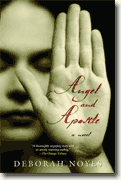Angel and Apostle
Deborah Noyes
book reviews:
· general fiction
· chick lit/romance
· sci-fi/fantasy
· graphic novels
· nonfiction
· audio books
· author interviews
· children's books @
curledupkids.com
· DVD reviews @
curledupdvd.com
newsletter
win books
buy online
links
home
for authors
& publishers
for reviewers

 |
Angel and Apostle Deborah Noyes Unbridled Books Paperback 304 pages September 2006 |
|
Click here to read reviewer Luan Gaines' take on Angel and Apostle. At the end of The Scarlet Letter, the reader is left to wonder about the fate of Hester’s illegitimate child, Pearl. We know from Hawthorne’s prose that Pearl lived to middle age and had one child in Europe, but beyond that, her fate from the time of her childhood in New England to that time was never explored by Hawthorne. But Pearl, as a minor supporting character to Hester’s narrative, did not require further explanation.
The reader is first introduced to her as a child still living in New England where Pearl is willful, spoiled, and prone to tantrums. But through Noyes’ gifted use of language and description, the reader begins to see Pearl as more than just a willful and petulant child. Her mother, who is at best vague toward her daughter and at worst ignores her completely, neglects Pearl. Pearl’s first memory is of being rescued from the ocean by Dimsdale after her mother has left her there to drown. Hester, in Pearl’s eyes, is consumed by her humiliation and lost dreams. She has no room for this unwelcome child. She finds no comfort from the townsfolk either, as they torment and abuse her. She is easy game for those wishing to look down on someone else. Her very behavior excludes her from even those less self-righteous. In a society that requires women to work on household matters early in life, Pearl is an exception. She has little work to occupy her and those chores that are her responsibility, she ignores completely. As such, her only solace is in the forest or by the sea, and her only companions are imaginary. Pearl is a solitary individual whose very difference from those around her ostracizes her further. And yet she yearns for human contact and demonstrative love from her mother. Pearl’s world is soon altered when she comes across, in her many wanderings, a young blind boy named Simon Milton, the son of a well-respected merchant. Simon fascinates Pearl, as he does not immediately shun her, and many times, welcomes her company. Both children find equal benefit from their friendship. Simon, who through his infirmity is ostracized by society, finds an understanding soul in Pearl, and Pearl finds someone who is accepting of her as she is without alteration. Pearl becomes a regular visitor to the Milton household. Her visits often meeting with frowns from the adults who disapprove of her association with Simon, but despite the crticism, she is never openly told to leave. After the death of Dimsdale a short time later, Pearl and her mother, with aid of Daniel Devlin, Dimsdale’s physician, travel to England to escape the ignominy that they have lived under for so long. Pearl is pleased by the adventure, but along the way, loses her best friend through her own forgetfulness. The story continues to follow Pearl as she grows and is thrust into the world of adulthood. In her narrative, Noyes includes all the characters from Hawthorne’s novel but shows them and their actions as a child might view them, impartially for some, judgmental for others, but perhaps more realistically than Hawthorne’s very romantic version of the events. The only flaw in Noyes’ narrative is her attempt to bring a moralistic ending to the novel, which undermines Pearl’s struggle that drives the book up to that point. Angel and Apostle follows Pearl’s path from childhood into adulthood, demonstrating her fierce, independent spirit as she searches to overcome obstacles between what she would wish for and what she has. Pearl’s story, ultimately, is a search for knowledge, acceptance, and her place in the world. Along the way she finds disappointment and the loss of many childhood dreams. Angel and Apostle is a worthy successor to Hawthorne’s classic, breathing life and sympathy into an enigmatic child. Originally published on Curled Up With A Good Book at www.curledup.com. © Elisha Darville, 2005 |
| Also by Deborah Noyes: |
|
|
|
 Click here to learn more about this month's sponsor! |
|
| fiction · sf/f · comic books · nonfiction · audio newsletter · free book contest · buy books online review index · links · · authors & publishers reviewers |
|
| site by ELBO Computing Resources, Inc. | |
 In Hawthorne’s narrative, the reader feels sympathy for Hester and Dimsdale, hatred for Chillingsworth, and confusion mixed with abhorrence for Pearl. However, in Deborah Noyes’ debut novel, Angel and Apostle, the reader is shown an entirely new perspective on Pearl.
In Hawthorne’s narrative, the reader feels sympathy for Hester and Dimsdale, hatred for Chillingsworth, and confusion mixed with abhorrence for Pearl. However, in Deborah Noyes’ debut novel, Angel and Apostle, the reader is shown an entirely new perspective on Pearl.